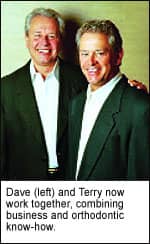by Terry Daugherty, DDS
A coachable clinician develops a passion for helping others build their practices

While still in Alexander’s practice, I started my own and modeled much of what I did after Alexander, Jay Barnett, and other very successful models. After my fourth year in solo practice I had six staff members and was grossing just more than $1 million per year. I was a good people person, a marketer, a very energetic person, and a good orthodontist. I went through what most orthodontists consistently go through with staff decisions: team highs and lows, and the feeling that, frequently, I was pulling the staff along toward the success that I was seeking as an orthodontist. I am sure my staff’s inspiration and commitment oscillated with my ability to create vision, communication, and good leadership.
It was easy to love orthodontics because of the tremendous transformational and life-enhancing value we give to the patients we treat. I have never lost the passion for the work, and I aspire to infect others with that passion. I had a very good practice and a talented staff. They executed better than most, yet I knew something was missing.
If I was to make my life simpler and elevate my team and my practice’s success to what we were capable of achieving, I needed to grow to a new level as an orthodontist-leader (CEO). At times, we all got stressed over management and communication issues. It was a challenge to be the orthodontist, boss, manager, and friend—all at the same time.
Then it happened! The answer came very unexpectedly. I was treating my brother Dave’s wife, and Dave offered to pay for the treatment by offering his business-consulting advice and coaching skills in exchange. He was a Fortune 100 CEO coach and a business-team-development expert for world-class companies. Yet, I wondered, what could he know about orthodontics? It’s such a unique business! I regularly did two off-site retreats per year with my staff, so I agreed to let Dave be our consultant for that year’s annual retreat. That experience changed my life.
Starting With a Vision
I was impressed in the beginning by his persistence with me in helping me discover my real vision for the practice (and my life). He talked to me not only about my vision for the practice but also about the gap between where I was then and where I wanted to be. We talked about leadership and developing a culture in my practice based upon my values and purpose, and how that would be connected with my staff’s core values. At first, this seemed too much on the “soft side” of practice success, yet it became tangible soon. My (now clear) vision helped me come more alive with passion, and caused me to develop a laserlike focus in my leadership and development of the practice culture in which I wanted to work and live.
Dave and I knew that the real drivers of practice success and fulfillment for all resided in the orthodontist’s most valuable asset: the staff. Our goal was to help the staff get the most out of themselves and push the envelope of what was possible by an inspired, passionate, and unified practice, using what we called Valued Partners™. These are the career-oriented knowledge workers who are engaged and passionate about the work and the practice. These are the 10s in a practice.
My staff loved Dave, and we all loved his perspective on the value of team unity. We worked through our strategies in practice management, clinical, financial, and marketing for practice growth and business health. I was shocked at what we accomplished, and we hired Dave to come in many times in the years that followed. He was a great coach for me and, in many ways, I was a great coach to him. We even joked about someday putting our talents and experience together and doing some consulting—the marriage of “highly successful business thinking and orthodontics.” Now, that is what we do for many other practices.
A Thriving Practice
My practice prospered; my team grew and developed professionally, personally, and financially each year. We had realized the true “Power of We” as a practice and business. We had orthodontists who would come out of residencies and want to work for a year (or so) with our practice, and that was really helpful. It further leveraged my time and effectiveness. I had seven associates over a period of 14 years. I ended up with the main practice and two branch practices, one of which was the size of a full practice.
Due to this success, many people came to visit our practice. Then I was asked to speak on practice effectiveness and team development. I had Dave as a coach; and I had a major passion for creative business development, staff development, and creative marketing strategies … I was having a ball. I loved to present my strategy and findings to groups and was a decent speaker and presenter. I did feel a spiritual “tugging” to create more fun, excitement, and value for my clients and to leverage what I had learned somehow in a bigger way—but I loved the practice, my team, our contribution. I was at the peak of my career. Then it happened.
A Career Cut Short
In early 1997, I suffered a hand injury that forced me to leave practice. Thankfully, I had an associate and two other orthodontists who wanted to take over my practices. Financially, I could easily have retired, but I felt that my practice joy and contribution had been cut short. I had a period of remorse and was disappointed over the forced loss of my ability to practice, my beloved team, and the great feeling I received through my contribution to the patients.
I retired to Hilton Head Island, South Carolina, had hand surgeries, and got the final confirmation that I would never practice again. Although we all have fantasized about what it would be like to retire and have time to pursue our other interests in life, it just isn’t all it is made up to be for someone who loves the business, the people, and the contribution we make to others. Contribution to others wasn’t the most important thing to me while in practice—largely because we contribute to our patients daily and we take it for granted, so we are “numbed to the miracles” we create daily.
A New Path
A few months went by after the hand surgeries. I was asked to be CEO of a small golf company, and later I was asked to run a relationship marketing program for a high-end golf-real estate development. I liked the new challenges. I grew personally and in business experience as a result, yet it never rivaled the passion I had for orthodontics.

Because of the nature of my practice experience, I had extensive knowledge of the associate-partner dynamics in orthodontic practice and its impact on the staff, the referring practices, and the community. The relational and practice-growth aspects of a practice in transition can be a minefield of problems that should be addressed before bringing in an associate or partner. The disruption and inefficiencies caused can be costly in both profitability and stress for the orthodontist and the staff.
Brothers in Arms
Fortunately, in late 2001 my brother came to visit and approached me about working together and blending our two specialties into a new paradigm of thinking and teaching in orthodontic consulting. He had 25 years’ experience as a corporate executive coach. We both knew our model worked to organize, manage, grow, and impassion practices. We knew we had the tools to help orthodontists develop themselves, their staff, and their practice strategies and systems into world-class small businesses. We knew it began with the orthodontist’s vision, good leadership, and the active development of a winning practice culture. And we rounded off Daugherty Consulting’s Fundamental 4 with what we called the Valued Partners.
What Are Valued Partners?
When we interviewed many orthodontists and asked how many of their staff members would they rate as perfect 10s, in a practice of 10, the common answer was about three or four—only one third! You don’t have to be a business or orthodontic guru to see that that is not a good number. Especially when we all realize that the staff drives the practice for better or worse; they have many more contact points with our patients, parents, and referring practices.
By the way, that committed 30% number, based upon our survey of staff members, is by no means a result of the staff wanting to be less than the best they can be in the practice.
So What’s the Disconnect?
Lack of a truly clear vision! I am not referring to that plaque on the wall called your mission statement. We find that most orthodontists really haven’t resolved what their true vision really is, and it is such a “soft” concept that they overlook it and race on toward the more tangible issues in the practice, sometimes confusing activity with accomplishment. True visionary orthodontists have found that once the vision is clear, the leadership path becomes clear and much easier. It unleashes a laser-like focus and passion toward the practice culture you desire and the success you deserve. Coincidently, most staffs will rally around the cause.
So What is Practice Culture?
Practice culture is basically, “the way we do things here,” what and who we are as a practice, the way we behave, our work ethic, our practice values, and how we and others view us as a practice team. All great companies have a great culture. Culture becomes the framework for how we hire and why we fire, and a powerful draw for people who want to be part of “our kind of practice.” The vision is transformed to culture through good leadership. The Daugherty Consulting leadership approach is simple, yet effective. Our survey results with staff members shows that most staffs believe that their orthodontist is not a great leader; yet most orthodontists interviewed believe they are good leaders. Either way, it requires some simple leadership skills to transform your staff into Valued Partners.
The End of the Story
Back to the transition from practice to consulting. A couple of takeaways are that being a consultant is one of the hardest jobs that I have ever had. The profession you are now in, no matter how famous you are, will likely not immediately embrace you as a consultant for a variety of reasons. If you are willing to take a pay cut and are reasonably comfortable with taking 3 to 5 years to build up a consulting practice, then go for it. The other consultants have been great to me, and they are an honorable group of professionals. As my friend Joe O’Neil says, “It’s hard until it becomes easier.”
While practicing, I studied a great deal about how great businesses became world-class businesses. I read lots of relational psychology about teams, patients, and customer service. I tried to apply what I had to my practice—when I had time. Now, we get to spend much more research time in our busy speaking and consulting practice. We constantly study world-class businesses principles and apply them to practices.
We are in the final stages of releasing our Practice Success System™ products that we teach in our consulting business. They will be on CDs and in workbook formats. We will launch a quarterly CD subscription that will offer innovative practice ideas, practice pearls, and inspirational information and messages (one for orthodontists and one for staff).
We do seminars on subjects ranging from team development, to practice growth strategies, to transition dynamics. Additionally, we are creating Master-Mind Groups that are “think tank” environments for practices of specific levels. We facilitate the group thinking around enhancing the entire group’s practice success.
We love what we do, and I needed the added challenge and stimulation after leaving practice. It is a labor of love, and I feel very blessed to be doing what I am doing with my career as a founder-partner in Daugherty Consulting. Orthodontists are great to work with, and the results can be remarkable.
Terry Daugherty, DDS, is co-founder of and partner in Daugherty Consulting. He has spoken at several AAOAnnual Sessions. He can be reached at [email protected].








